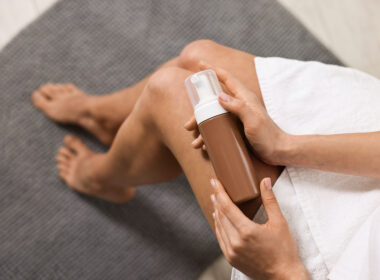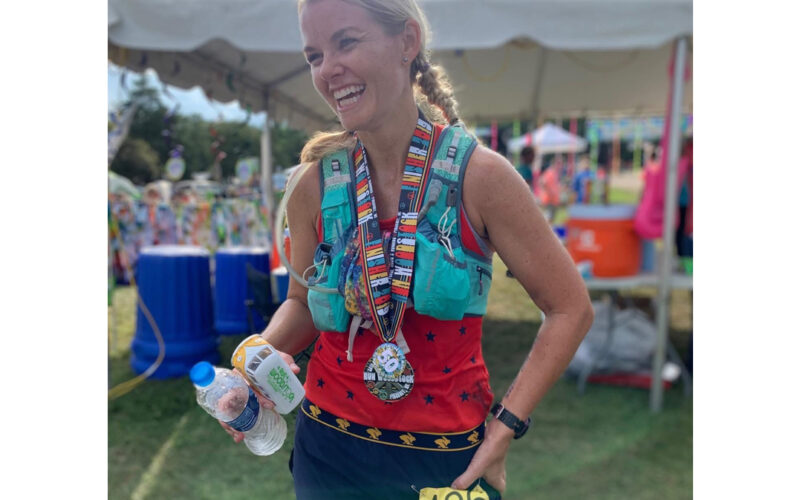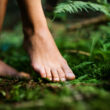You are probably aware of the unique gifts (and challenges) that come with womanhood, including the menstrual cycle. Here at Natural Womanhood, helping women embrace the way their bodies are designed is the core of our mission. A woman who is fully living out her femininity, embracing her fertility and the natural design of her body, is one step closer to the flourishing she is made for! I recently had the privilege of interviewing a woman who is doing just that: embracing her femininity and the vocation of motherhood… as well as her love of ultrarunning! She gave great insight about training (whether for long distance running or another sport) in a way that is conducive to motherhood, but also emphasized the importance of giving yourself grace as you navigate all the various seasons of life and fertility.
Meet Emily
Emily Blain, 40, started running when she was eleven years old and hasn’t stopped since. A cross country runner in high school and a tennis player in college, she enjoys being active in general, but has always come back to distance running as a form of leisure. She laughed as she told me she doesn’t know how many marathons she has run… Besides completing many, many formal races, she regularly laces up her shoes and logs miles for hours at a time. Needless to say, her experience completing over fifteen ultramarathons, amidst four pregnancies and motherhood, is certainly unique!
Fueling the body…for running y salud ciclista
One of the first questions I asked Emily was how running long distances has impacted her cycle health over the years. She shared that her training caused lighter periods in her young adult years, but that she never struggled with amenorrea, which is common among female endurance athletes. As a female runner, having a healthy cycle is incredibly important for both athletic success and overall well being. Although each woman is unique, and some can handle more intense training than others, Emily thinks women can intentionally foster cycle health while training by prioritizing nutrition and rest.
Although each woman is unique, and some can handle more intense training than others, Emily thinks women can intentionally foster cycle health while training by prioritizing nutrition and rest.
Personally, Emily makes sure to eat plenty of protein and fresh produce when she is training, but she is no stranger to carbohydrates, either! Additionally, she prioritizes rest. Sleep is “easy to forget when you’re serious about training,” but your body will respond to a lack of it because it is crucial for recovery.
Running as a mom
Pre-Pregnancy
Emily has four children, ages 4-13, and she has run before, during, and after every one of her pregnancies. Emily even emphasized the importance of training for pregnancy itself, especially via strength training. This not only reduces your chances of injury and is beneficial for your baby, but prepares your core and pelvic floor muscles for the changes that come throughout pregnancy and with delivery [1].
Emily even emphasized the importance of training for pregnancy itself, especially via strength training. This not only reduces your chances of injury and is beneficial for your baby, but prepares your core and pelvic floor muscles for the changes that come throughout pregnancy and with delivery.
She engages in strength training más than she runs, and this has helped her recover postpartum and return to running injury-free.
During Pregnancy
Emily emphasized the importance of mindfully considering your personal and family history when discerning whether to continue running during pregnancy. It is especially important to consult your doctor while making this decision. For some, running is a great way to maintain cardiovascular fitness. For others, it might be best to stick to walking. During her pregnancies, Emily chose to run through the first trimester, after which she switched to walking, “not because it felt like too much, but because [she] wanted to protect [her] pelvic floor.” Throughout the second and third trimesters, Emily focused on walking and strength training.
Postparto
During pregnancy, the pelvic inlet widens to allow the baby to pass through during delivery. Because of this change, you can reasonably expect your postpartum gait to be slightly different than it was before pregnancy. What this means postpartum is slowly easing back into running. Emily shared that she focuses exclusively on strength training and terapia del suelo pélvico for six months postpartum. She also “makes [her]self promise that [she] won’t do any impact training” during that time, so that her body has time to heal properly after pregnancy and childbirth.
How to stay healthy for life as a female runner or other athlete
For all those women out there who want to continue to enjoy exercise throughout their lives, Emily had some very helpful tips.
1. Be gentle with yourself
The reproductive lifespan of a woman comes with a lot of change. Some is regular and consistent, like the cyclical hormonal fluctuations of each cycle, but some is less predictable and consistent, such as the many changes that occur throughout puberty, pregnancy, postpartum, and around menopause. It’s easy for women to fall into the trap of thinking they “should” look or “should” be able to perform the way they used to.
Emily encourages a different approach, which revolves around being gentle with yourself. Do not fret if you can’t run as fast or squat as deep as you did pre-pregnancy or as a young adult! In time, with patience and perseverance, you can increase your strength and stamina. Giving yourself grace and focusing on holistic wellness in your current state will lead to better and healthier results long-term than trying to take on old routines too quickly!
2. Nourish your body
You might be tempted to embrace the latest diet fad, but Emily cautions against these. Due to a woman’s fluctuating carbohydrate needs throughout the menstrual cycle, and the reality that most research is done on men, Emily thinks women should approach even “research-based” diets with caution.
If you want to promote long-term wellness and optimize your performance, she thinks protein should be a primary focus—especially from well-sourced meat and dairy products. Additionally, taking steps to eat organic fruits and vegetables and plenty of carbs (especially if you are very active) will fuel your body and give you the energy to perform. Finally, taking supplements can be a great way to boost your vitamin and nutrient intake (especially iron, for all those female athletes), but these should only add to an already balanced diet, not replace fruits and vegetables!
3. Strength train
Strength training is a great way to support your long-term physical health. Not only does strength training boost muscle mass, support bone health, and help with weight loss, but (if done correctly) it can also help women maintain healthy pelvic floor and core muscles [1]. This is key for women who hope to be active throughout their lives, especially after having children. Focusing on strength training (especially after having a baby, but also) throughout your life will support your pursuit of fitness!
4. Be grateful
One mile might not seem like an accomplishment when you’re used to running ten, but Emily chooses to focus on gratitude, especially during seasons when she can’t perform like she previously did. You never know which mile is going to be your last, so “running one mile and being grateful to God for every single one” is important.
You never know which mile is going to be your last, so “running one mile and being grateful to God for every single one” is important.
Fostering an attitude of gratitude will help you see each mile as a gift and an accomplishment, rather than a sub-performance compared to the past!
The call to motherhood is a gift
It’s easy to “should” yourself, especially when you find yourself in a new season where you can’t move as fast or do as much as you used to do. Specifically during postpartum though, Emily encourages women to embrace the season they’re currently in. If your ability (or even your desire) to workout is lower than before baby, she thinks there is nothing wrong with embracing the newborn snuggles over an afternoon walk. Giving yourself permission to fully be present in your current stage will bring a lot more peace than holding yourself to a strict schedule.
If you’re struggling to decide whether to jump back into fitness after the 6-week “all clear” from your doctor or midwife, be honest with yourself about your abilities, and take more time off if needed. Remember Emily’s self-imposed 6 months of recovery postpartum? Even though six months of no running might seem like eternity, Emily points out that over the course of your life, “it’s a very short amount of time.” Looking back, Emily said she wishes she had given herself permission to enjoy being the mom of a newborn, rather than feeling like she “should” be getting back to running sooner. She encouraged, “Make sure you prioritize focusing on where you should be focusing. Lean into the season that you’re in, and enjoy the ride.”
Even though the world may not see it this way, Emily thinks putting a pause on your workouts and personal goals “for the greater good” of having children is nothing to be ashamed of. In fact it’s something to be proud of! Motherhood (and womanhood!) is an incredible gift, and allowing yourself to fully embrace it is one of the best things you can do for your children, as well as yourself.







